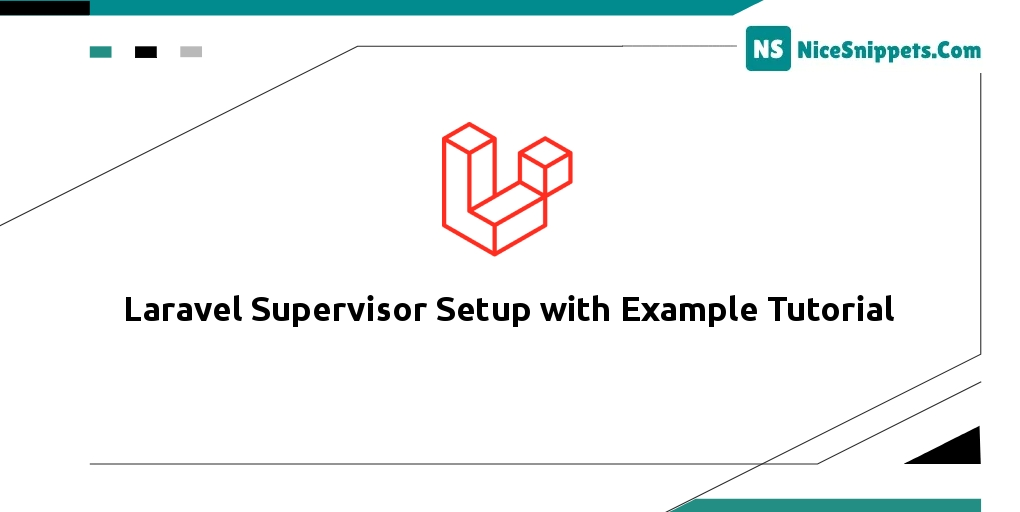10-Apr-2023
.
Admin

Hello Friends,
Do you require background task processing for the Laravel 9 project? Typically, large-scale operations that require a significant task, such sending emails or uploading large files, may take a long time to complete. And you don't want your user to wait till the task has been completed successfully. Because of this, Laravel has a queueing approach that allows you to use Laravel Supervisor to process your task in the background. The user is then simply informed that your task has been processed correctly.
In this tutorial, you will be able to learn how to set up the Laravel 9 supervisor and Laravel queue with the database.
Step 1: Install Laravel
This is optional; however, if you have not created the laravel app, then you may go ahead and execute the below command:
composer create-project laravel/laravel example-app
Step 2: Supervisor Setup
With the Laravel queue connection, we have a wide range of alternatives, including redis, amazon sqs, and even databases. However, we are utilising the database in this instance.
To start kindly run the following command
// to generate jobs table in migrations
php artisan queue:table
// then run migrate after the jobs migrations generated
php artisan migrate
Step 3: Setup Laravel Supervisor
To configure the supervisor you need to open your Linux terminal window and run the following command:
//update dependencies and install supervisor
sudo apt update && sudo apt install supervisor
//check supervisor status after the installation
sudo systemctl status supervisor
Output

As we can see our supervisor is now active. So let's configure our Laravel project file for our supervisor worker.
# then navigate supervisor config folder
cd /etc/supervisor/conf.d
# then create Laravel project configuration file
sudo nano project-name-worker.conf
Then paste the below code:
[program:project-name-worker]
process_name=%(program_name)s_%(process_num)02d
command=php /var/www/project-name.com/public_html/artisan queue:work --sleep=3 --tries=3
autostart=true
autorestart=true
user=ubuntu
numprocs=8
redirect_stderr=true
stdout_logfile=/var/www/project-name.com/public_html/storage/logs/worker.log
stopwaitsecs=3600
NOTES
1.Be sure that you input your exact project directory for replacing /var/www/project-name.com/public_html
2.user value must be your logged user name. In my case is ubuntu.
3.and also the stdout_logfile change it to your project directory.
Let's run the following command
//to read the new supervisor configurations
sudo supervisorctl reread
//then activate the new configuration
sudo supervisorctl update
//to start the queue command
//take note that this is the name of our config file above.
//You can change it depending on your project name.
sudo supervisorctl start project-name-worker:*
//then check status if configured correctly
sudo supervisorctl status
Another method is this
// it will stop all queue
sudo supervisorctl stop all
// then read new configuration
sudo supervisorctl reread
// then update so that it will activate then newly added
sudo supervisorctl update
// then start all queues
sudo supervisorctl start all
// then check status
sudo supervisorctl status
Step 4: Setup Laravel Queue
So in this example, let's say you have user management and the admin can invite users via email. So let's implement the Laravel queue on this so that the user invitation will run in the background.
Then run the following command
php artisan make:job UserInvitationJob
App/Jobs/UserInvitationJob.php
<?php
namespace App\Jobs;
use Illuminate\Bus\Queueable;
use Illuminate\Contracts\Queue\ShouldBeUnique;
use Illuminate\Contracts\Queue\ShouldQueue;
use Illuminate\Foundation\Bus\Dispatchable;
use Illuminate\Queue\InteractsWithQueue;
use Illuminate\Queue\SerializesModels;
class UserInvitationJob implements ShouldQueue
{
use Dispatchable, InteractsWithQueue, Queueable, SerializesModels;
/**
* Create a new job instance.
*
* @return void
*/
public function __construct()
{
//
}
/**
* Execute the job.
*
* @return void
*/
public function handle()
{
//
}
}
Now we have our UserInvitationJob class for our Laravel queue user invitation. Next, we will update user UsersController.php for our invitation or create a new user and then send the invitation.
App/Http/Controllers/UsersController.php
<?php
namespace App\Http\Controllers;
use App\Models\User;
use Illuminate\Http\Request;
use App\Http\Requests\StoreUserRequest;
class UsersController extends Controller
{
/**
* Store a newly created user
*
* @param User $user
* @param StoreUserRequest $request
*
* @return \Illuminate\Http\Response
*/
public function store(User $user, StoreUserRequest $request)
{
//For demo purposes only. When creating user or inviting a user
// you should create a generated random password and email it to the user
$user = $user->create(array_merge($request->validated(), [
'password' => 'test'
]));
dispatch(new \App\Jobs\UserInvitationJob($user));
return redirect()->route('users.index')
->withSuccess(__('User created successfully.'));
}
}
As you can see we added dispatch(new \App\Jobs\UserInvitationJob($user)); code which is we use to invite user and implement it with Laravel queue.
Then in our UserInvitationJob class, we will update the code to send the email invitation and run it through the background with the Laravel supervisor.
App/Jobs/UserInvitationJob
<?php
namespace App\Jobs;
use App\Models\User;
use Illuminate\Bus\Queueable;
use Illuminate\Queue\SerializesModels;
use Illuminate\Queue\InteractsWithQueue;
use Illuminate\Contracts\Queue\ShouldQueue;
use Illuminate\Foundation\Bus\Dispatchable;
use Illuminate\Contracts\Queue\ShouldBeUnique;
class UserInvitationJob implements ShouldQueue
{
use Dispatchable, InteractsWithQueue, Queueable, SerializesModels;
protected $user;
/**
* Create a new job instance.
*
* @return void
*/
public function __construct(User $user)
{
$this->user = $user;
}
/**
* Execute the job.
*
* @return void
*/
public function handle()
{
$userDetails = $this->user;
//send email invitation here
}
}
After all, our Laravel supervisor and Laravel queue are ready. You can integrate it with your own functionalities. But before we do that don't forget to update the ENV config for the QUEUE_CONNECTION value.
QUEUE_CONNECTION=database
I hope it can help you...
#Laravel